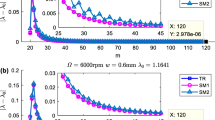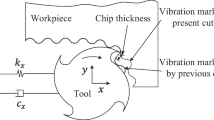Abstract
Stability prediction with both high computational accuracy and speed is still a challenging issue and has been attracting significant attention from the academia and industry. This study presents a Legendre-Chebyshev-based stability analysis method (LCM) for milling operations. According to the cutting state, it divides the system period of milling model into the free and the forced vibration time periods. By introducing appropriate transformation, the latter time interval is further discretized nonuniformly into the Chebyshev-Gauss-Lobatto points, which has explicit expression. Then, the state term over the discrete time points is approximated with the Legendre expansion, and its corresponding derivative is acquired via a novel and efficient algorithm. Thereafter, Floquet matrix within the system period of milling model can be determined for predicting the system stability via the known Floquet theory. Finally, we validate the effectiveness of the LCM by employing the single and two degrees of freedom (DOF) milling operations and making detailed comparisons with the recent representative algorithms, which indicates that the presented Legendre-Chebyshev-based method has both high prediction accuracy and speed.





Similar content being viewed by others
References
Cui XB, Zhao B, Jiao F, Zheng JX (2016) Chip formation and its effects on cutting force, tool temperature, tool stress, and cutting edge wear in high- and ultra-high-speed milling. Int J Adv Manuf Technol 83:55–65
Song QH, Ai X, Tang WX (2011) Prediction of simultaneous dynamic stability limit of time-variable parameters system in thin-walled workpiece high-speed milling processes. Int J Adv Manuf Technol 55:883–889
Munoa J, Beudaert X, Dombovari Z, Altintas Y, Budak E, Brecher C, Stepan G (2016) Chatter suppression techniques in metal cutting.CIRP. Ann Manuf Techn 65(2):785–808
Quintana G, Stepan CJ (2011) Chatter in machining processes: a review. Int J Mach Tools Manuf 51(5):363–376
Tao JF, Qin CJ, Xiao DY, Shi HT, Ling X, Li BC, Liu CL (2019) Timely chatter identification for robotic drilling using a local maximum synchrosqueezing-based method. J Intell Manuf. https://doi.org/10.1007/s10845-019-01509-5
Altintas Y (2012) Manufacturing automation: metal cutting, mechanics, machine tool vibrations, and CNC design. Cambridge University Press, New York
Tao JF, Qin CJ, Xiao DY, Shi HT, Liu CL (2019) A pre-generated matrix-based method for real-time robotic drilling chatter monitoring. Chin J Aeronaut 32(12):2755-2764
Dong XF, Qiu ZZ (2019) Stability analysis in milling process based on updated numerical integration method. Mech Syst Signal Process. https://doi.org/10.1016/j.ymssp.2019.106435
Altintas Y, Stepan G, Merdol D, Dombovari Z (2008) Chatter stability of milling in frequency and discrete time domain. CIRP J Manuf Sci Technol 1(1):35–44
Hajdu D, Insperger T, Stepan G (2017) Robust stability analysis of machining operations. Int J Adv Manuf Technol 88(1–4):45–54
Tao JF, Qin CJ, Liu CL (2019) A synchroextracting-based method for early chatter identification of robotic drilling process. Int J Adv Manuf Technol 100:273–285
Tao JF, Zeng HW, Qin CJ, Liu CL (2019) Chatter detection in robotic drilling operations combining multi-synchrosqueezing transform and energy entropy. Int J Adv Manuf Technol 105(7–8):2879–2890
Davies MA, Pratt JR, Dutterer B, Burns TJ (2002) Stability prediction for low radial immersion milling. J Manuf Sci E-T ASME 124:217–225
Smith S, Tlusty J (1993) Efficient simulation programs for chatter in milling. CI RP Ann Manuf Techn 42:463–466
Li ZQ, Liu Q (2008) Solution and analysis of chatter stability for end milling in the time-domain. Chin J Aeronaut 21:169–178
Campomanes ML, Altintas Y (2003) An improved time domain simulation for dynamic milling at small radial immersions. J Manuf Sci E-T ASME 125:416–422
Urbikain G, Olvera D, López de Lacalle LN (2017) Stability contour maps with barrel cutters considering the tool orientation. Int J Adv Manuf Technol 89(9–12):2491–2501
Roukema JC, Altintas Y (2006) Time domain simulation of torsional-axial vibrations in drilling. Int J Mach Tools Manuf 46(15):2073–2085
Altintas Y, Budak E (1995) Analytical prediction of stability lobes in milling. CIRP Ann 44(1):357–362
Budak E, Altintas Y (1998) Analytical prediction of chatter stability in milling—part II: application of the general formulation to common milling systems. ASME J Dyn Syst Meas Control 120(1):31–36
Merdol SD, Altintas Y (2004) Multi frequency solution of chatter stability for low immersion milling. J Manuf Sci Eng 126(3):459–466
Wu Y, You Y, Jiang J (2019) A stability prediction method research for milling processes based on implicit multistep schemes. Int J Adv Manuf Technol 105(7–8):3271–3288
Butcher EA, Ma HT, Bueler E, Averina V, Szabo Z (2004) Stability of linear time-periodic delay-differential equations via Chebyshev polynomials. Int J Numer Methods Eng 59(7):895–922
Butcher EA, Bobrenkov OA, Bueler E, Nindujarla P (2009) Analysis of milling stability by the Chebyshev collocation method: algorithm and optimal stable immersion levels. J Comput Nonlin Dyn 4:031003
Insperger T, Stepan G (2002) Semi-discretization method for delayed systems. Int J Numer Methods Biomed Eng 55(5):503–518
Insperger T, Stepan G (2004) Updated semi-discretization method for periodic delay-differential equations with discrete delay. Int J Numer Methods Biomed Eng 61(1):117–141
Insperger T, Stepan G, Turi J (2008) On the higher-order semidiscretizations for periodic delayed systems. J Sound Vib 313(1):334–341
Dong XF, Zhang W, Deng S (2016) The reconstruction of a semi-discretization method for milling stability prediction based on Shannon standard orthogonal basis. Int J Adv Manuf Technol 85:1501–1511
Dong XF, Zhang WM (2019) Chatter suppression analysis in milling process with variable spindle speed based on the reconstructed semi-discretization method. Int J Adv Manuf Technol 105:2021–2037. https://doi.org/10.1007/s00170-019-04363-0
Jiang SL, Sun YW, Yuan XL, Liu WR (2017) A second-order semi-discretization method for the efficient and accurate stability prediction of milling process. Int J Adv Manuf Technol 92(1–4):583–595
Ding Y, Zhu LM, Zhang XJ, Ding H (2010) A full-discretization method for prediction of milling stability. Int J Mach Tools Manuf 50(5):502–509
Sun Y, Xiong Z (2017) High-order full-discretization method using Lagrange interpolation for stability analysis of turning processes with stiffness variation. J Sound Vib 386(1):50–64
Ozoegwu CG, Omenyi SN (2016) Third-order least squares modelling of milling state term for improved computation of stability boundaries. Prod Manuf Res 4(1):46–64
Ozoegwu CG, Omenyi SN, Ofochebe SM (2015) Hyper-third order full-discretization methods in milling stability prediction. Int J Mach Tools Manuf 92:1–9
Tang X, Peng F, Yan R, Gong Y, Li Y, Jiang L (2017) Accurate and efficient prediction of milling stability with updated full discretization method. Int J Adv Manuf Technol 88(9-12):2357–2368
Yan Z, Wang X, Liu Z, Wang D, Jiao L, Ji Y (2017) Third-order updated full-discretization method for milling stability prediction. Int J Adv Manuf Technol 92(5–8):2299–2309
Qin CJ, Tao JF, Liu CL (2018) A predictor-corrector-based holistic-discretization method for accurate and efficient milling stability analysis. Int J Adv Manuf Technol 96:2043–2054
Qin CJ, Tao JF, Liu CL (2019) A novel stability prediction method for milling operations using the holistic-interpolation scheme. Proc IME Part C: J Mechanical Engineering Science 233(13):4463–4475
Olvera D, Elías-Zúñiga A, Martínez-Alfaro H, López de Lacalle LN, Rodríguez CA, Campa FJ (2014) Determination of the stability lobes in milling operations based on homotopy and simulated annealing techniques. Mechatronics 24:177–185
Qin CJ, Tao JF, Shi HT, Xiao DY, Li BC, Liu CL (2019) A novel Chebyshev-wavelet-based approach for accurate and fast prediction of milling stability. Precis Eng 62:244-255
Ding Y, Zhu LM, Zhang XJ, Ding H (2011) Numerical integration method for prediction of milling stability. J Manuf Sci Eng 133(3):031005
Ding Y, Niu JB, Zhu LM, Ding H (2016) Numerical integration method for stability analysis of milling with variable spindle speeds. ASME. J Vib Acoust 138(1):011010
Li MZ, Zhang GJ, Huang Y (2013) Complete discretization scheme for milling stability prediction. Nonlinear Dyn 71:187–199
Li ZQ, Yang ZK, Peng YR, Zhu F, Ming XZ (2016) Prediction of chatter stability for milling process using Runge-Kutta-based complete discretization method. Int J Adv Manuf Technol 86(1):943–952
Ding Y, Zhu LM, Ding H (2014) A wavelet-based approach for stability analysis of periodic delay-differential systems with discrete delay. Nonlinear Dyn 79(2):1049–1059
Lu YA, Ding Y, Peng ZK, Chen ZZC, Zhu LM (2017) A spline-based method for stability analysis of milling processes. Int J Adv Manuf Technol 89:2571–2586
Zhang Z, Li HG, Meng G, Liu C (2015) A novel approach for the prediction of the milling stability based on the Simpson method. Int J Mach Tools Manuf 99:43–47
Zhang XJ, Xiong CH, Ding Y, Ding H (2017) Prediction of chatter stability in high speed milling using the numerical differentiation method. Int J Adv Manuf Technol 89:2535–2544
Qin CJ, Tao JF, Li L, Liu CL (2017) An Adams-Moulton-based method for stability prediction of milling processes. Int J Adv Manuf Technol 89(9–12):3049–3058
Tao JF, Qin CJ, Liu CL (2017) Milling stability prediction with multiple delays via the extended Adams-Moulton-based method. Math Probl Eng 2017:1–15
Qin CJ, Tao JF, Liu CL (2017) Stability analysis for milling operations using an Adams-Simpson-based method. Int J Adv Manuf Technol 92(1–4):969–979
Zhang W, Ma H (2008) The Chebyshev-Legendre collocation method for a class of optimal control problems. Int J Comput Math 85(2):225–240
Canuto C, Hussaini MY, Quarteroni A, Zang TA (2012) Spectral methods in fluid dynamics. Springer Science & Business Media
Acknowledgments
This work was partially supported by the National Key R&D Program of China (Grant No. 2018YFB1702503), the Science and Technology Planning Project of Guangdong Province (Grant No. 2017B090914002), and the China Postdoctoral Science Foundation (Grant No. 2019M661496).
Author information
Authors and Affiliations
Corresponding author
Additional information
Publisher’s note
Springer Nature remains neutral with regard to jurisdictional claims in published maps and institutional affiliations.
Rights and permissions
About this article
Cite this article
Qin, C., Tao, J., Xiao, D. et al. Accurate and efficient stability prediction for milling operations using the Legendre-Chebyshev-based method. Int J Adv Manuf Technol 107, 247–258 (2020). https://doi.org/10.1007/s00170-020-05040-3
Received:
Accepted:
Published:
Issue Date:
DOI: https://doi.org/10.1007/s00170-020-05040-3




